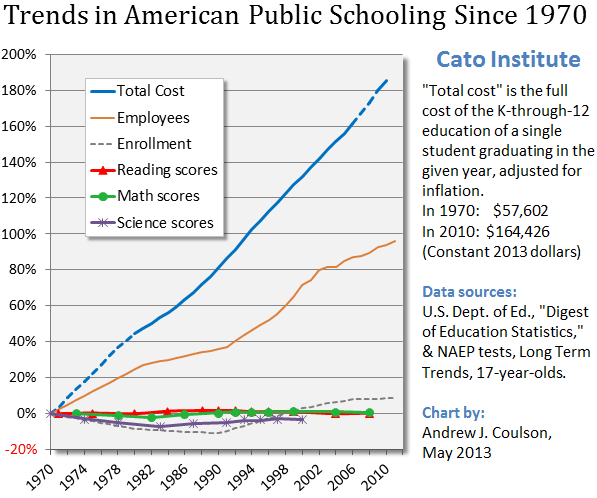

Newark Prep Charter School students listen to academic coach, Robbie Garland. (Photo: Reuters)
While I have great fondness for some of the visuals I’ve created over the years (especially “two wagons” and “apple harvesting“), I confess that none of my creations have ever been as clear and convincing as the iconic graph on education spending and education outcomes created by the late Andrew Coulson.

Source: CATO
I can’t imagine anyone looking at his chart and not immediately realizing that you don’t get better results by pouring more money into the government’s education monopoly.
But the edu-crat lobby acts as if evidence doesn’t matter. At the national level, the state level, and the local level, the drumbeat is the same: Give us more money if you care about kids.
So let’s build on Coulson’s chart to show why teachers’ unions and other special interests are wrong.
Gerard Robinson of the American Enterprise Institute and Professor Benjamin Scafidi from Kennesaw State University take a close look at this issue.
…education is important to the economic and social well-being of our nation, which is why it is the No. 1 line item in 41 state budgets. …Schools need extra money to help struggling students, or so goes the long-standing thinking of traditional education reformers who believe a lack of resources – teachers, counselors, social workers, technology, books, school supplies – is the problem. …a look back at the progress we’ve made under reformers’ traditional response to fixing low-performing schools – simply showering them with more money – makes it clear that this approach has been a costly failure.
And when the authors say it’s been a “costly failure,” they’re not exaggerating.
Since World War II, inflation-adjusted spending per student in American public schools has increased by 663 percent. Where did all of that money go? One place it went was to hire more personnel. Between 1950 and 2009, American public schools experienced a 96 percent increase in student population. During that time, public schools increased their staff by 386 percent – four times the increase in students. The number of teachers increased by 252 percent, over 2.5 times the increase in students. The number of administrators and other staff increased by over seven times the increase in students. …This staffing surge still exists today. From 1992 to 2014 – the most recent year of available data – American public schools saw a 19 percent increase in their student population and a staffing increase of 36 percent. This decades-long staffing surge in American public schools has been tremendously expensive for taxpayers, yet it has not led to significant changes in student achievement. For example, public school national math scores have been flat (and national reading scores declined slightly) for 17-year-olds since 1992.
By the way, the failure of government schools doesn’t affect everyone equally.
Parents with economic resources (such as high-profile politicians) can either send their kids to private schools or move to communities where government schools still maintain some standards.
But for lower-income households, their options are very limited.
Minorities disproportionately suffer, as explained by Juan Williams in the Wall Street Journal.
While 40% of white Americans age 25-29 held bachelor’s degrees in 2013, that distinction belonged to only 15% of Hispanics, and 20% of blacks. …The root of this problem: Millions of black and Hispanic students in U.S. schools simply aren’t taught to read well enough to flourish academically. …according to a March report by Child Trends, based on 2015 data from the National Assessment of Educational Progress (NAEP), only 21% of Hispanic fourth-grade students were deemed “proficient” in reading. This is bad news. A fourth-grader’s reading level is a key indicator of whether he or she will graduate from high school. The situation is worse for African-Americans: A mere 18% were considered “proficient” in reading by fourth grade.
But Juan points out that the problems aren’t confined to minority communities. The United States has a national education problem.
The problem isn’t limited to minority students. Only 46% of white fourth-graders—and 35% of fourth-graders of all races—were judged “proficient” in reading in 2015. In general, American students are outperformed by students abroad. According to the most recent Program for International Student Assessment, a series of math, science and reading tests given to 15-year-olds around the world, the U.S. placed 17th among the 34 Organization for Economic Cooperation and Development countries in reading.
This is very grim news, especially when you consider that the United States spends more on education – on a per-pupil basis – than any other country.
Here’s a table confirming Juan’s argument. It lacks the simple clarity of Andrew Coulson’s graph, but if you look at these numbers, it’s difficult to reach any conclusion other than we spend a lot in America and get very mediocre results.
Juan concludes his column with a plea for diversity, innovation, and competition.
For black and Hispanic students falling behind at an early age, their best hope is for every state, no matter its minority-student poverty rate, to take full responsibility for all students who aren’t making the grade—and get those students help now. That means adopting an attitude of urgency when it comes to saving a child’s education. Specifically, it requires cities and states to push past any union rules that protect underperforming schools and bad teachers. Urgency also means increasing options for parents, from magnet to charter schools. Embracing competition among schools is essential to heading off complacency based on a few positive signs. American K-12 education is in trouble, especially for minority children, and its continuing neglect is a scandal.
He’s right, but he should focus his ire on his leftist friends and colleagues. They’re the ones (including the NAACP!) standing in the proverbial schoolhouse door and blocking the right kind of education reform.





?⛄Arianna⛄? / December 20, 2016
it just means we’re being stolen from and more indoctrination in the schools.
/